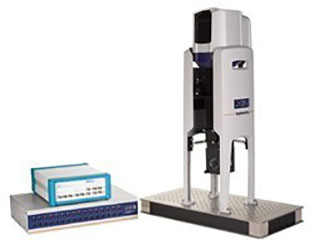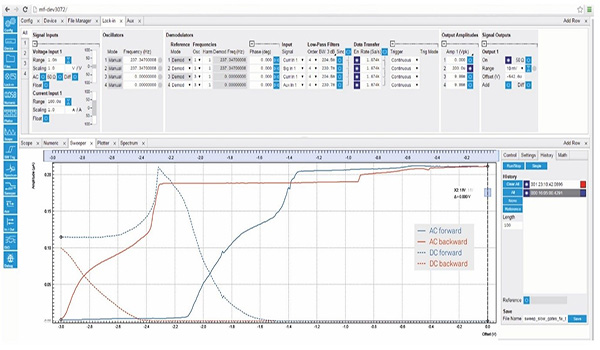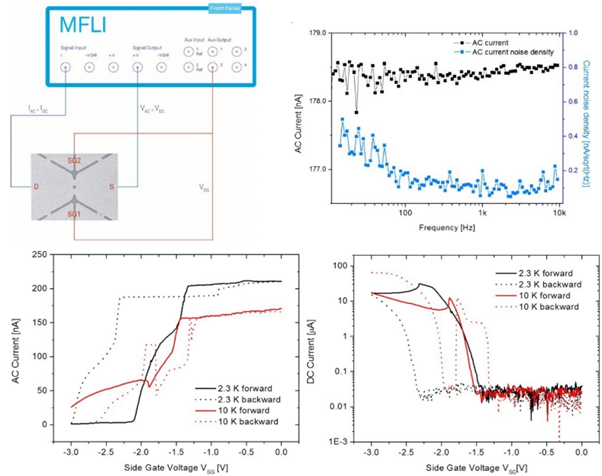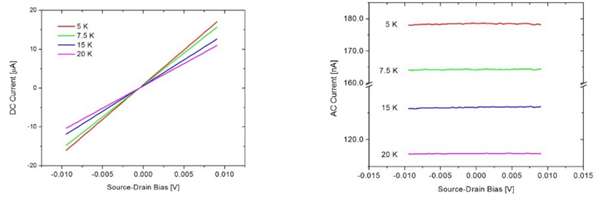Resources
 Part of the Oxford Instruments Group
Part of the Oxford Instruments Group
Expand
Collapse
 Part of the Oxford Instruments Group
Part of the Oxford Instruments Group
Efficient electrical nanodevice characterisation with OptistatDry cryostat and MFLI Lock-in Amplifier.
In this application note we demonstrate a procedure to carry out various characterisations of a QPC (Quantum Point Contact) device in an OptistatDry cryostat from Oxford Instruments and using an MFLI Lock-in Amplifier from Zurich Instruments. The sample was provided by the Semiconductor Physics Group in the Cavendish Laboratory at University of Cambridge, UK.
Qubits, or quantum bits, are basic building blocks of a quantum computing device. There are many implementations and proposals for such a device and all of them need a read-out mechanism to work reliably. For GaAs or semiconducting QDs (quantum dots), QPCs are a way to readout the charge state of a qubit. Solid state qubit operation is carried out at much lower (milliKelvin) temperatures where the coherence times are longer, but the QPC functionality can be readily checked at and around 4 K. The OptistatDry provides a compact and easy to use cold environment.
The MFLI features integrated tools that provide an out-of-the box set of electrical measurements. All the measurements described here have been performed in less than one day, providing a state-of-the-art integration and combination for high-end research.

Figure 1. SampleProtect measurement system set-up including OptistatDry cryostat, MFLI Lock-in Amplifier and an ESD break-out box - used for this application.
Operating between DC and 5 MHz, the MFLI is a digital dual-phase demodulator Lock-in Amplifier. The front panel is equipped with current input (I) and differential voltage input/outputs (V), two auxiliary inputs (AuxIn) and four 18-bit auxiliary outputs (AuxOut). The two AuxIns connectors can be used for external signal referencing but also to add analog DC bias to the signal outputs. Furthermore, a digital path for adding the DC component onto the signal output is available through the user interface. The AuxOuts can be used to output the demodulated signal (X, Y, R, theta) components as well as for the manual or automated voltage bias sweeps. Furthermore, with the multi-demodulator (MF-MD) option, a total of four demodulators are available. This allows for simultaneous I and V measurements and/or demodulation at four different frequencies at the same time, including DC. An example of such configuration is shown in Figure 2. The MFLI is controlled by the LabOne user interface which provides a comprehensive analysis toolset including oscilloscope, spectrum analyser, parameter sweeper and several more. This makes the MFLI an excellent choice for device characterisation and measurements.

Figure 2. A screenshot of the MFLI LabOne user interface from Zurich Instruments. The top panel provides the instrument configuration settings of the MFLI device with the multi-demodulator (MF-MD) option. The bottom graph shows the Sweeper tool with AC (full) and DC (dotted) current measurements of the forward (blue) and the backward (red) gate voltage sweeps.
In a QPC, a 1D quantum channel is formed by applying an electrostatic potential onto a 2D electron gas formed below the GaAs top layer. The QPC device structure can be seen in Figure 3a. The current conductance between the source-drain leads and side gate electrodes (with an anti-dot) form a QPC. Another top-gate is available over a cross-linked PMMA; however, this is not used in the measurements described in this note.
The OptistatDry is a Cryofree, closed-cycle refrigerator cooled, tabletop cryostat offering a temperature range down to below 3 K, which can be achieved in less than 3 hours from room temperature. The sample is in a vacuum environment but is easily accessed via a load port. Sample mounting is achieved via a demountable sample puck. The puck can include a thermometer for accurate sample temperature reading and a heater for fine temperature control. The sample space has multi-axis optical access via up to 5 windows and electrical access via the sample puck.
The QPC sample was mounted in a chip insert, and the PLCC chip carrier was mounted on the sample puck using GE varnish. The electrical contacts were wire bonded from the PLCC carrier to the sample puck using fine Al wires. Extra wire bonded links were added to ensure sample node equipotential during handling.
Mounting in the OptistatDry is simply a matter of loading the puck using the vacuum tool or tweezers. An anti- static wrist strap must be worn. Tightening three screws ensures good thermal contact with the cooling plate and good electrical contact with the spring-loaded pins. The cabling of the experimental set-up includes an ESD break-out box between the OptistatDry and the MFLI, see Figure 1. This enables all signal lines to be grounded to ensure the sample is at equipotential via the instrumentation signal lines. The lines are individually switchable and can be separately switched to ground or to the MFLI. With all the lines switched to ground it is possible to cut the ESD protection link wires on the puck. To begin the device characterisation experiment the signal lines are switched to the MFLI.
The conductance (I-V) measurements are done via source-drain electrodes and transport is modified via the two side gates electrodes, as shown in the Figure 3a. The source drain voltage excitation was 200 μV and the current is measured at the 100 μA input range with full input bandwidth up to 5 MHz. The side gates are driven simultaneously using one AuxOut of the Lock-in Amplifier.
The continuity of the sample was first checked at the room temperature, and it was cooled down to the base of 2.3 K. Using the Scope tool of the LabOne user interface the overall noise spectrum at the input has been checked (not shown). To choose the optimal measurement region a frequency sweep was run using the LabOne Sweeper tool in the range from 10 Hz to 10 kHz, revealing flat AC current frequency response (black curve, Figure 3b). Subsequent noise measurements (blue curve, Figure 3b) reveal up to four times higher noise below the corner frequency of 100 Hz, so the measurement frequency of 237 Hz was chosen for these particular tests.
The tests carried out consisted of measuring both AC and DC current components of the source-drain conductance to monitor the transport for leakage currents. This is done using the MFLI MF-MD option which allows the measurement frequency to be set at the 0 Hz for the DC and at the AC frequency using two demodulators simultaneously. The LabOne Sweeper tool was used to sweep the AuxOut voltage driving the side gates. To setup the sweeps we manually change side gate voltage in small steps of 10 mV. It was noticed, using the Plotter tool of LabOne UI (not shown), that the currents are relaxing on long time scales, so we chose to set the wait time 60 s to monitor the equilibrium state. Voltage sweeps were done between 0 to -3 V and back. An example of the finished sweeps of AC and DC currents, at 2.3 K (black) and 10 K (red), are shown in Figures 3c and 3d respectively (dotted curves are backward sweeps). We see that overall, the conduction current drops in the channel as the temperature increased due to the activation of additional scattering mechanisms. We note further that the pinch off of the channel is at about -3 V and that there are several conductance reduction steps along the way. A large hysteresis is also observed in the back sweep revealing that significant charge transfer is taking place upon the end of the long sweep. We also note that AC and DC currents have sharp changes at the same gate voltages pointing to the current leakage in the device, most prominently between the side gates and the drain electrode.
Furthermore, we measured the I-V characteristics of source-drain electrodes at various temperatures and side gate voltage of -1.3 V. The DC bias is digitally added together with the AC excitation. The measurement results at four different temperatures from 5 K to 20 K are shown in Figure 4. The source-drain bias was limited to 10 mV. We see that the I-V characteristics, Figure 4a, are linear as confirmed by the practically flat AC current response, Figure 4b.

Figure 3a. The measurement schematics and lead connection to MFLI Lock-in Amplifier. Figure 3b. AC current (black) and the current noise density (blue) plotted as a function of frequency obtained using the Sweeper tool. AC (Figure 3c) and DC (Figure 3d) current measurements as a function of the side gate voltage swept at temperatures 2.3 K (black) and 10 K (red), forwards (full) and backwards (dotted).

Figure 4. The DC (Figure 4a.) and AC (Figure 4b.) current measurements as a function of the side gate voltage bias taken at four different temperatures from 5 K to 20 K.
We show that characterisation of a QPC device can be done efficiently as a function of source-drain and gate bias, at multiple temperatures and frequencies. OptistatDry allows for fast and accurate temperature control whilst the built-in oscilloscope of the MFLI can help solve set-up ground loop and various potential noise source issues. The fast frequency sweep points to the optimal measurement frequency. The MF-MD option allows for simultaneous AC and DC current measurements, with high signal to noise ratio, as a function of side gate bias quickly revealing the presence of the leakage currents. The source-drain sweeps show the linearity of the contacts that can be taken for different side gate voltages and temperatures.
In this note, it was demonstrated how combining the equipment from Oxford Instruments and Zurich Instruments leads to efficient and cost-effective laboratory setups. The time to first characterisation is below one day and this is a major step towards the objective of reducing time to publication.
The combined expertise of the two instrument vendors enables customers who need to efficiently harness electrical and optical experiments performed as low as 2.3 K. The use of advanced user interfaces such as LabOne reduces the programming effort for users as it provides an extensive out-of-the-box toolset ready for many immediate analyses. This reduces setup complexity and potential failure modes compared to using multiple external measurement tools.
Date: August 2022
Author: Simon Mitchinson (Oxford Instruments)
Category: Application Note
